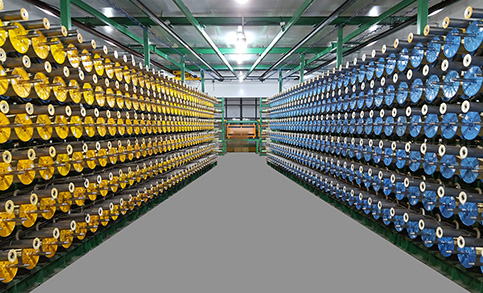During the manufacturing process of radial tyres, presence of high humidity leads to rusting of steel wires and loss of strength as rusting prevents proper bonding between the steel and rubber, resulting into large rejection rate.
General Recommendation :
Relative Humidity in the Creel Room must be maintained between 20±5% at 25±5°C.
The Radial Tyre: A radial tyre is an improvement on the conventional / bias tyre. The essential difference is the placement of piles and the addition of belts. In a conventional / bias tyre the piles run diagonally across the tyre from bead to bead. In each successive layer, the cords run in opposite directions. In a radial tyre, the cords are radially placed, perpendicular to the central line of the tyre.
The radial is an improvement over the conventional / bias tyre on many fronts- a longer life, lower fuel consumption, greater riding comfort and skid resistance, which explains the shift from the conventional ply technology.
All radials are however not the same. The piles may be encased in a belt made of steel, fibre glass, rayon or nylon fabric. However the radials in which the belt is made of steel instead of fabric or fibre glass are the most efficient.
The steel belted radials are, therefore the most commonly used radials. The only disadvantage observed, is the rusting of steel belts over a period of time leading to the tyre’s quicker wear and tear. Using the nylon casing over the steel eliminates rusting during usage. However due care is always required during the manufacturing stage, to see that rusting of steel belts does not occur during the bonding process.
The Manufacturing Process
Manufacturers follow various processes for preparing the multilayer tyres. Some use only steel belts for that added strength, others add cross knitting of steel wires, which makes it stronger.
The room in which steel wires are covered with fabric, converting it into a single bonded ribbon, which is, than braided, is referred to as the Creel Room.
In the Creel Room, various wires of fabric and steel pass to the winding machine from large spools. Presence of high humidity in this room leads to rusting of steel wires, leading to a large rejection rate and loss of strength. Rusting prevents proper bonding between the steel and rubber.
Dehumidification of Creel Room therefore becomes a vital application area.
Bry-Air Solution
Bry-Air has installed several dehumidifiers in creel rooms for all the well-known tyre companies maintaining conditions of 20±5% RH.
Due to the nature of the manufacturing, the area surrounding the creel room may be at a temperature and humidity higher than normal ambient conditions.
In the Creel Room, various wires of fabric and steel pass to the winding machine from large spools. This total area is taken into consideration while calculating moisture load. Also, sufficient make-up air is introduced to provide the positive pressure in the space.
It is also imperative that when the cord leaves the creel room, it must travel through ambient air. At this time, if the temperature of the cord is below the dewpoint temperature of this ambient, moisture will condense on it and be trapped in the finished ply. Therefore, the cord must never leave the creel room unless it is at a temperature above the dewpoint temperature of the ambient air it will pass through.
Tyres incorporating the superior radial tyre technology have withstood the test for a longer life than conventional tyres. All this has been made possible due to adherence to quality manufacturing practices. Adding a desiccant dehumidifier to protect the steel cord ensures a “lasting bond, which never tires”.













